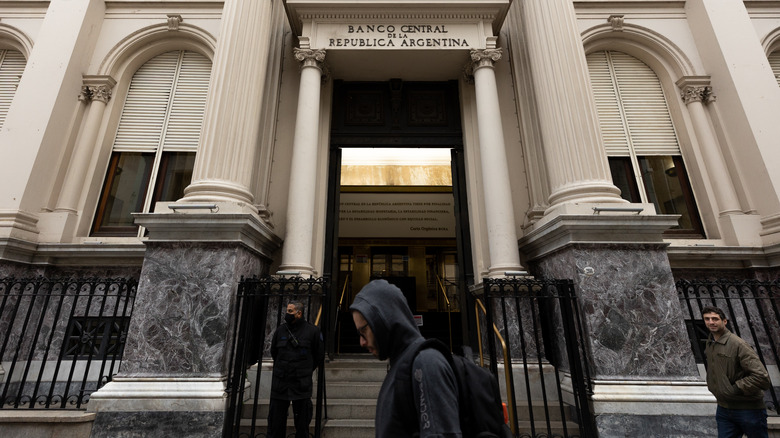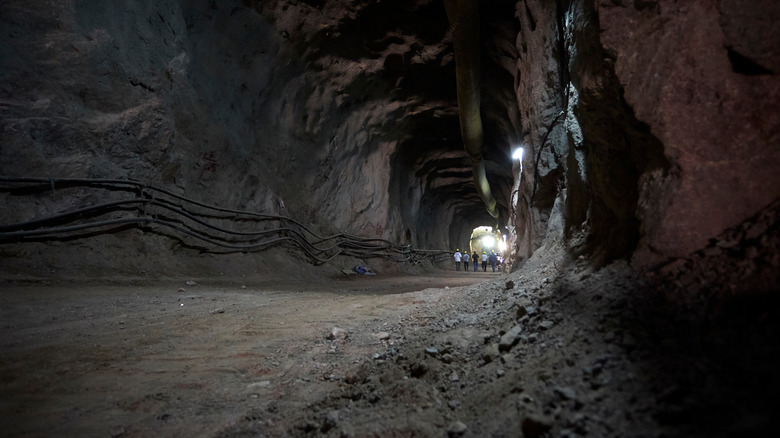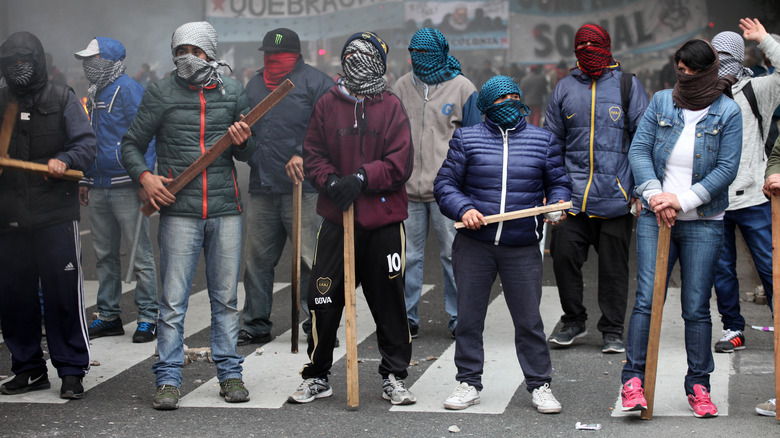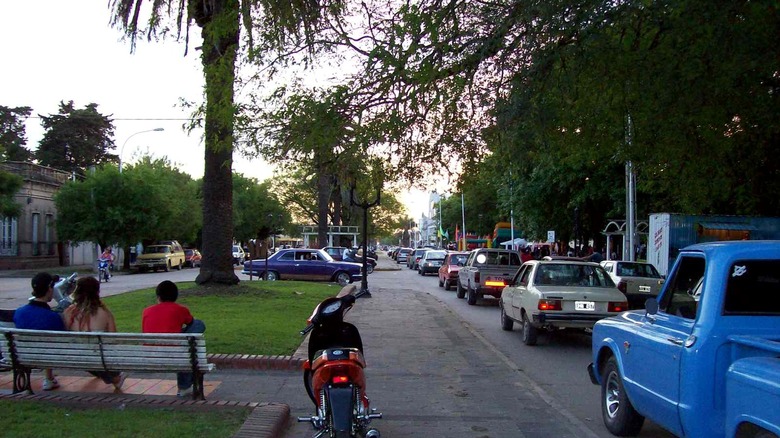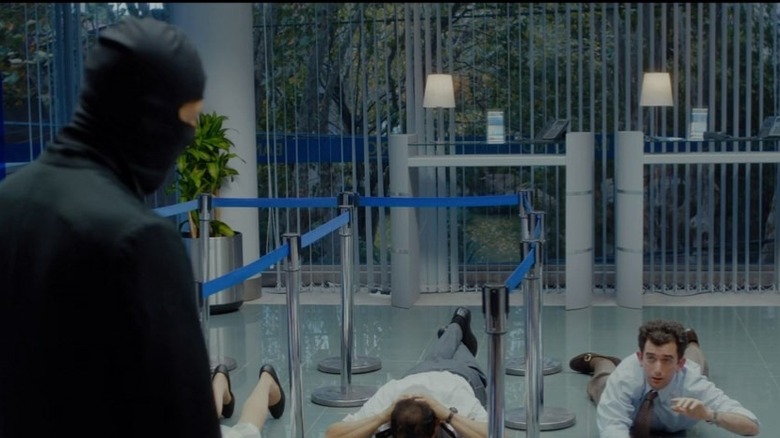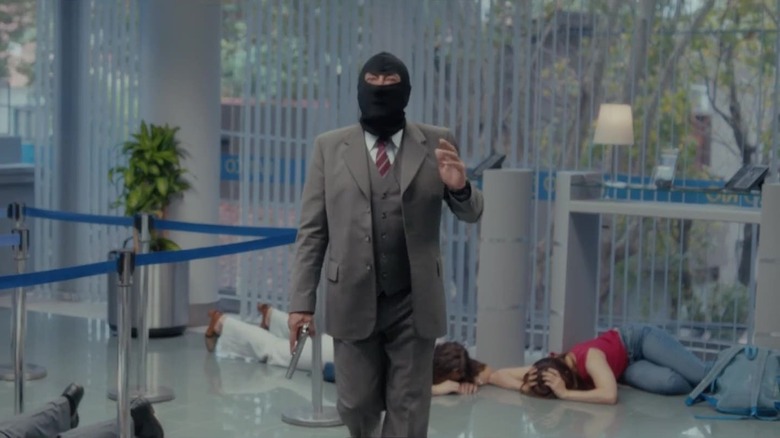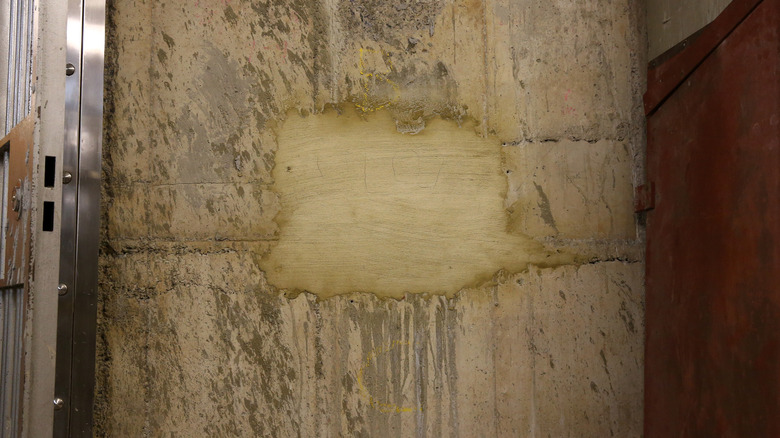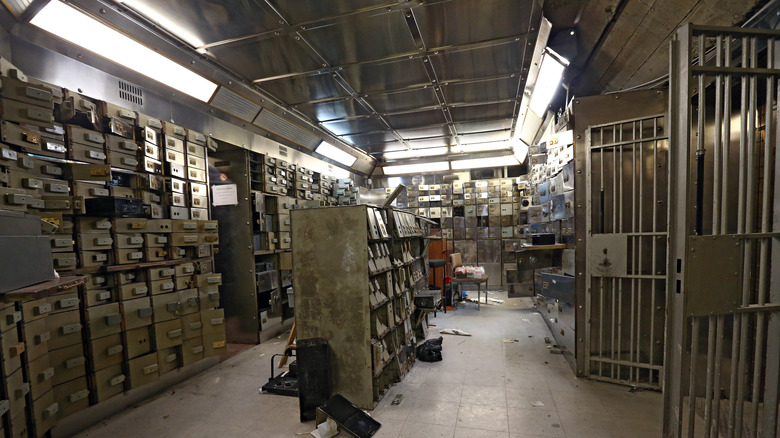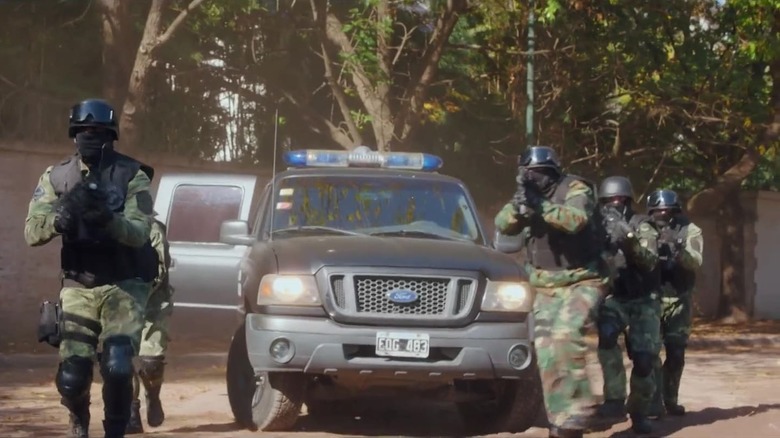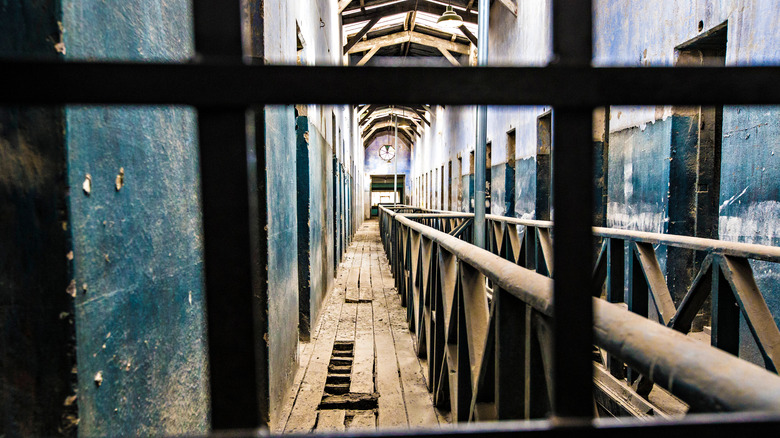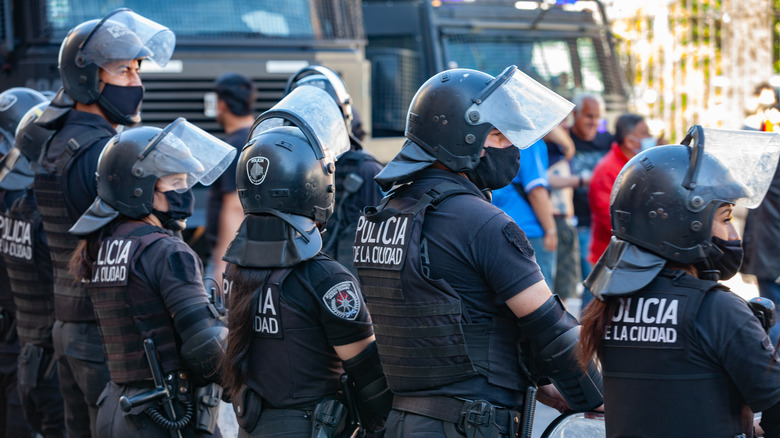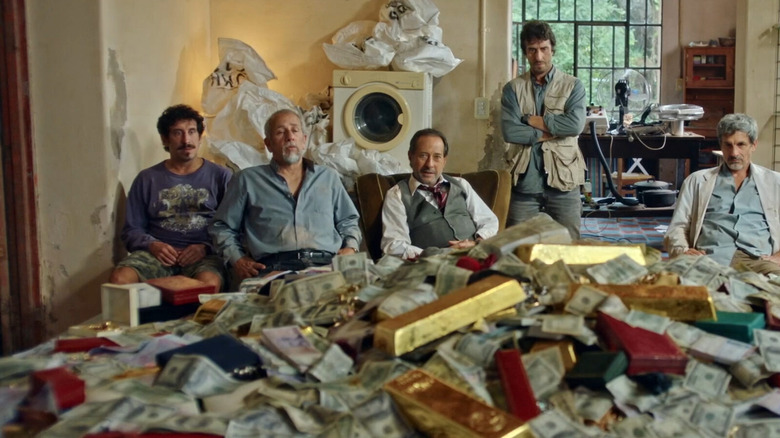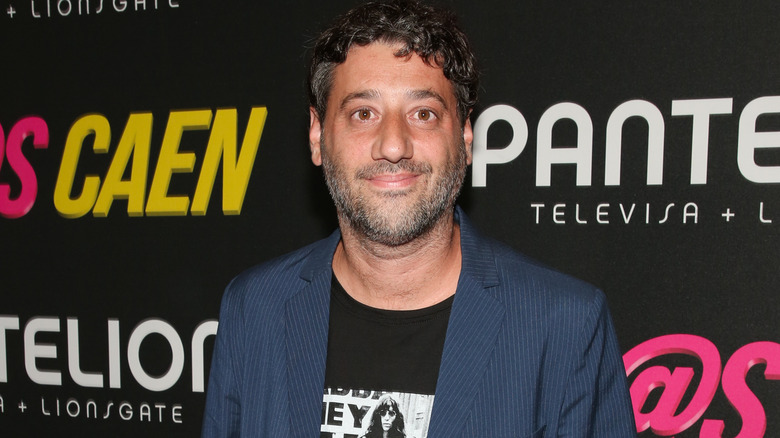The Buenos Aires Bank Heist Of 2006 Explained
In 2006, a unit of highly-trained Argentine special forces made their way into a bank near Buenos Aires (via GQ). Armed assailants had forced their way into the building and taken nearly two dozen innocent people as hostages for hours — and then things went quiet. By 7:00 p.m., the authorities that had surrounded the financial institution refused to wait any longer and ordered their men to enter the premises.
Within, the police found the hostages safe and sound, if slightly rattled, but there was no sign of the masked criminals. Instead, law enforcement discovered a row of toy guns and a handwritten message that said (via GQ), "In a neighborhood of rich people, without weapons or grudges, it's just money, not love." Also missing was an enormous sum of money worth between $20-$25 million. Here is the truly gripping story behind one of the most impressive heists of the century.
Tunnel robberies were common in South America
The subterranean theft near Buenos Aires may have been one of the most spectacular heists of all time, but it was certainly not the only robbery involving tunnels in South America. In fact, digging thieves had become such a threat to banking customers in Argentina since 1988 that attorney Nydia Zingman was able to make a living representing the victims of these crimes (via The Washington Post). Yet the worst of the underground heists occurred in the neighboring country of Brazil just a few months before in 2005.
At Fortaleza, criminal masterminds set up a fake landscaping store as a front and then dug underneath the building to a vault 262 feet away (via the Associated Press). When Richard Chamberlain, the owner of a used bookstore next to the store, was speaking with the outlet, he said, "I never saw them selling anything, and, in fact, I never saw any plant or grass for sale in that house. I'm not sure how many people worked in that house, but I would say more than five. The man who seemed to be the owner of the establishment was a friendly person who at times would pay for a round of beer in a nearby bar."
To explain how no one noticed, he added (via the Associated Press), "The tunnel was dug underneath one of the city's busiest and noisiest avenues, so it would be hard to notice anything unusual." Even more successful than the famous Argentinian heist, the thieves in Brazil managed to get away with $67.8 million from the Central Bank.
Argentinians did not trust the banks
In 2001, terrible banking practices and political decisions led to one of the worst — if not the worst — financial crises to ever occur in Argentina. Almost overnight, the wealth of people from all walks of life was nearly wiped out, so the citizenry grew to hate both the banks and those in power at the time. Historian Felipe Pigna explained to the AFP news agency (via the Buenos Aires Times), "There was a strong sense of orphanhood, distrust of institutions, the state, and the banks." As people took to the streets, they cried out, "Thieves, thieves, give back the savings!"
Sebastián García Bolster, one of the masterminds behind the Buenos Aires heist, was deeply affected by the crisis as well and was his main motivation for participating in the criminal activity. In an interview with Josh Dean for his book, "The Great Buenos Aires Bank Heist," Bolster said (via GQ), "I watched my father working all my life, and I saw how the banks stole his money. Well, I went to get it back."
Since many no longer felt like they could rely on financial institutions to store their cash, it became common practice to store wealth like jewelry and other valuables in an alternative manner. As Martina Castro, executive producer of "The True Heist of the Century" explained on CNBC's "Super Heists" (via Oxygen), "Overnight the local currency devalues by an insane amount, people have lost their entire savings, their retirement accounts, but guess what doesn't get touched? Anything that's in a safe deposit box." The precious caches locked in vaults then became the prime targets of underground robbers.
Argentinians were haunted by Ramallo
Even though it had occurred several years before in 1999, the notoriously brutal robbery in Villa Ramallo was still etched into the memories of Argentinians in 2006 (via the Los Angeles Times). The reason the incident 125 miles north of Buenos Aires was so terrifying is because it ended a gunfight with law enforcement, which then resulted in the tragic deaths of two hostages.
When the armed thieves were surrounded by 200 police at the local branch of the Banco de la Nación for 13 hours, they then attempted to flee using the hostages as human shields, according to the Los Angeles Times. The cops opened fire and managed to take out one of the robbers, but their assault lacked precision and killed both the bank manager and an accountant, along with injuring the wife of the manager. Argentinians watched the horrific event on live TV, and people were outraged over the failed operation. Many believed the authorities did not do enough to prevent the deaths of the innocent victims.
The crew took two years to prepare
The man who started it all, Fernando Araujo, wanted to avoid the circumstances that occurred during the disaster at Ramallo, so he came up with the audacious plan to tunnel underneath a bank and escape without any violence committed (via GQ). He then enlisted his good friend, engineer Sebastián García Bolster, to help, and the two major masterminds behind the operation spent two whole years to prepare.
The two could not carry out the complicated feat all on their own, especially since neither of them had any criminal experience prior to the heist. Therefore, Araujo also recruited several professional thieves, including Rubén Alberto de la Torre (often called Beto), Luis Mario Vitette Sellanes, Julián Zalloecheverría, and two other men known simply as Doc and Luis the Uruguayan. While all of them had vital roles to play, Vitette was especially important not only because of his vast experience but even more so since he had the funds to finance the entire operation with a massive $100,000 investment. And regardless of their criminal pasts, each one was on board to strike at the banks without harming any innocents. As Araujo explained to them (per GQ), "We have to earn the popular outcry."
The duo had formed their team to carry out the heist, but Bolster preferred to work alone underground. The engineer spent several months sneaking away into the drainage tunnels late at night to dig a hole leading up to the subterranean wall of the bank. Even though his wife certainly noticed his bizarre absences, she had no idea what he was actually doing and simply assumed he was just having an affair.
Thieves entered the bank and took hostages
On January 13, several of the armed robbers arrived at the branch of Banco Río in an affluent suburb north of Buenos Aires and entered through the front doors to quickly take 23 hostages among the customers and employees. The cops were quickly alerted to the situation and surrounded the building until 300 officers arrived on the scene. Not only were most of the police heavily armed with rifles and shields, but there were also four snipers perched high above and ready to act if necessary, according to El País.
Even though the firearms the crew carried were not real, neither the hostages nor the police were aware of that, so the thieves were in complete control of the situation within the building (via Oxygen). Outside, several news outlets captured the event from every angle, which may have influenced law enforcement to proceed with more caution, especially to avoid another terrible situation like Ramallo. The hesitance of the police also helped Sebastián García Bolster get the two hours he needed to complete his objective underground.
Negotiating with the Man in the Gray Suit
While the four other crew members either stood guard over the hostages or helped Sebastián García Bolster seize the contents of the vault, Luis Mario Vitette Sellanes was in charge of distracting the police (via GQ). When the cops secured radio contact with the robbers, Vitette stepped forward and identified himself as Walter, although his distinct clothing led the cops to quickly call him "The Man in the Gray Suit."
Right away, law enforcement became deeply confused, because not only did the robbers let three of the hostages go, but Vitette and another thief were even heard singing "Happy Birthday" to one of the bank employees. Yet, Vitette also made sure to mention Ramallo and say the crew was prepared to use deadly force if necessary, which was completely untrue. It was all clever manipulation to buy time and put the cops on edge, so they would question their own strategy going forward. The leader, Fernando Araujo, later explained the main goal to author Josh Dean and said that he told the crew (per GQ), "We must look nervous and stupid, like we're losing control." He then added that viewers watching the news "must have sympathy for us." Araujo also confirmed that Vitette had taken acting classes and put coins in his mouth to improve the deception.
Police stormed the building
Luis Mario Vitette Sellanes, while still in the guise of Walter, continued to act strangely from the perspective of the negotiators as he now demanded a large order of pizzas and sodas in exchange for four of the hostages (via The Washington Post). Yet after the trade went through and the innocents were released unharmed, the police no longer heard from "The Man in the Gray Suit" no matter how hard they tried to get back into contact with him.
Seven hours from the start of the incident, law enforcement lost their patience and finally stormed the building, according to The Washington Post. All the remaining hostages were found within, and they had been treated well given the circumstances. On the other hand, the cops were not able to find any of the robbers because the hole in the basement that they escaped through was sealed with a large iron lid secured from the other side of the tunnel. Another key thing missing was the valuable contents from over 140 out of 400 safe-deposit boxes, all worth at least $20 million (via GQ).
The crew watched the police on TV
While the crew upstairs kept the police preoccupied, the thief known simply as "Doc" helped Sebastián García Bolster get through the wall in the basement (via GQ). The engineer then went to work smashing open as many safe-deposit boxes as possible. To complete the task, Bolster constructed a device he called the power cannon, which was basically a jackhammer strong enough to break the locks and could be separated into parts, then reassembled.
Once the two hours were up, the thieves gathered up all the precious goods and used a raft to transport it through the subterranean tunnels. And before they left, the crew also cleverly dropped hair from a barber shop throughout the financial institution, causing further confusion when the authorities began their investigation. But by that point, the robbers were long gone. The heist had gone so well that once they had made it to the getaway vehicle, the utterly successful criminals were able to watch the police storm the bank on TV like the rest of the Argentinians.
One rocky relationship was their downfall
The heist was almost perfect, with every member of the crew getting away completely free. However, freedom for most of the crew would not last long. Five weeks after the extraordinary heist, the wife of Rubén Alberto de la Torre, Alicia di Tullio, was fed up with her husband (per GQ). Alicia said she knew Beto was cheating on her with a girlfriend, and she could not take the thought that he might leave her with the new woman. The scorned spouse had only meant to give up Beto to the authorities, but since she had seen most of the other members — Araujo, Bolster, Vitette, and Zalloecheverría — they all went down with their comrade as well. Alicia later apologized to the other men and asked for their forgiveness. However, the police were never able to identify Doc and Luis the Uruguayan, so the two have eluded law enforcement to this day.
When talking with author Josh Dean, Beto swore that he never had any intention of leaving his wife. He also admitted how angry and shocked he was by her actions and said (via GQ), "I never thought she would do that." And since he's the reason they all were caught, Beto added, "I will always be angry, for the rest of my life."
Most of the crew served some prison time
Even though the legendary robbers were ultimately caught, none of them served longer than five years in prison. The short sentences were primarily due to the fact that none of them used real weapons, just toy guns, according to El País. After they were convicted as criminals, none of the professional thieves regretted taking part in the heist. In fact, the general feeling was that it was one of the greatest accomplishments of their lives.
Out of the members of the crew that served time, Sebastián García Bolster spent the least amount in jail, with only 25 months (per GQ). The engineer avoided a longer sentence because he was only charged with the crime of assisting the crew in digging the tunnel. Luis Mario Vitette Sellanes would have served several more years after his conviction, yet his lawyers were able to reduce his sentence to four years. He was then deported back to Uruguay and prohibited from ever returning to Argentina.
Police were supposed to update their protocol
Prior to the Buenos Aires bank heist, law enforcement only made sure that exits above ground were monitored during a robbery, which included the obvious routes through doors and windows, along with more complicated escapes from rooftops or through walls into adjacent buildings. However, since the crew had used tunnels so effectively, the police were forced to change their strategy from that point on. Sebastián García Bolster explained to author Josh Dean that the officials referred to the implemented procedure as "the Man in the Gray Suit Protocol" (via GQ).
For the new process, the possibility that robbers might be using deception was not only more accepted — it became something to consider for every case going forward. Furthermore, officers were required to access blueprints under the foundation in order to block escapes leading underground, or at least to consider monitoring these routes as well. Yet, in 2011, the adopted protocol seems to have been neglected during another successful tunnel heist in Buenos Aires. This time around, the crew operated when the Banco Provincia branch was closed and set off alarms more than once in the process, says the BBC. However, the police did nothing because the doors to the building were sealed shut.
The crew became folk heroes
Since Sebastián García Bolster was not involved with the criminal lifestyle beforehand in any way whatsoever and Fernando Araujo's experience was also minimal, they both acknowledged the immorality of their actions to some extent. Bolster even admitted to author Josh Dean that people's reactions to him were a bit strange. The engineer said (via GQ), "No one has ever said anything bad to me. On the contrary, many people congratulate me. That's very confusing. I know it's wrong to steal. But they congratulate me ... to understand this, you have to be Argentine."
The getaway driver, Julián Zalloecheverría, was previously a career criminal, so he was significantly less conflicted with his actions. But he also did not expect to be treated the way he was after the heist. Years after retiring from his life of crime, Zalloecheverría enrolled in law school and was somewhat disturbed when professors approached him for photos or stories about the famous robbery.
Approval for the heist did not just come from those who interacted with the former thieves, as many Argentinians were quite vocal about their admiration. Salvador Peluso, an employee of the water-sports store near the bank was among them, and he told The Washington Post, "Everyone I know is talking about it and saying the same thing — that the people who did it are geniuses. They robbed a bank without a single gunshot being fired and got away with everything. It's like a good movie."
Several books and an Argentinian film were made about the heist
Now famous after their legendary heist, a few of the crew members separately collaborated with journalists to tell their version of the event. Beto de la Torre spoke with one journalist who wrote "Without Arms or Grudges," but after its release, he decided it was not accurate enough and teamed up with a different writer for "Robbery of the Century: The Secret History," as reported by GQ. Julián Zalloecheverría was the only one convicted who did not want to be involved with any of these books since Luis Vitette has his own version of the story as well.
Fernando Araujo and Sebastián García Bolster were heavily involved in the most ambitious project, a highly fictionalized comedy film called "El Robo del Siglo," or "The Robbery of the Century," released in 2020. While Bolster consulted and appeared in the movie, Araujo wrote the original script.
Spanish series La Casa de Papel is extremely similar
In 2017, Netflix purchased the rights to the Spanish series "La Casa de Papel" and released it to a global audience. The show, now called "Money Heist," became an instant hit and led to several seasons. Like the famous Buenos Aires heist, the series tells the story of an individual mastermind — the Professor — who assembles a team of professionals to pull off one of the greatest robberies of all time. Since "Money Heist" is so similar, the members of the OG Buenos Aires crew enjoyed it and, for the most part, considered it an honor to their legacy.
On the other hand, the real story and the fictional tale have so much in common that Fernando Araujo considered suing the writers of the Spanish series. According to infobae, his major issue was minor aspects that appeared to be taken directly from his book, though ultimately, he decided not to take legal action because he is a fan of the show.
